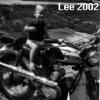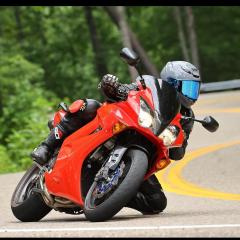Leaderboard
Popular Content
Showing content with the highest reputation on 01/29/2018 in all areas
-
1 point
-
Steve, you beat me to the punch. Still trying to upload your supersize images and resize them!! :laugh: I coulda sworn I got all the burrs outta there... problem is, the swingarm is over 1/4" thick in that spot, makes it hard to get inside that 1/2" hole to deburr! Forgot I had an "inanout" tool here. :blush: More pics are coming, now everyone nows what the heck the brake bleeding thread was about! LOL! As also described in this thread: Click Here Steve (KeystoneVFR) contacted me about wanting to clean up the look of the rear of his bike by routing the brake lines through the swingarm. I suggested that he use aftermarket stainless steel lines and fittings for a few reasons. - they perform better than stock. - they're cheaper than stock(both stock lines from RonAyers cost ~$85, total cost of our lines and fittings was ~$75). - there are options for line colors and fittings to suit different looks/themes. - more importantly, they are smaller in diameter than the stock lines, meaning they could be routed through smaller holes(less material removed from the swingarm). The biggest "pro" to going with the stainless lines and personally assembling them, is that it allows for the smallest possible holes in the swingarm. The two fittings that connect to the bike are installed on two line ends, and attached to the bike. The lines are then routed through one of the factory chainguard locations(slightly enlarged), and through to the back of the swingarm. One line will come out of an existing hole that is slightly enlarged to 1/2". The other is routed out of a new 1/2" hole drilled 1" forward of the existing hole. The banjos ends are then connected to the ends of the lines, and bolted to the caliper. Start by getting the bike in a secure position with the rear wheel off the ground. You can probably get away with using the centerstand for this. I put Steve's bike on a lift, and locked the front wheel in, then put a scissor jack under the headers. Next remove the rear wheel, the footrest, and the chainguard. Next you will empty the rear brake reservoir and then bleed the rear caliper to get the fluid out, so you can remove the stock brake lines without making a mess. Have a roll of shop towels and some soapy water handy in case you do. Brake fluid is nasty stuff, and will eat your paint! I use rinsed-out milk and water jugs as catch-alls for this kind of stuff. Remove the banjo bolts at the caliper: Then the other ends on the bike. One is the block under the seat, use a 10mm wrench: The other is a banjo at the PC valve up by the battery(the one with the bleeder nipple on top). Remove the lines from the bike. Now is a good time to remove the bracket from under the hub locking bolt: Also a good time to clean your swingarm! Next you'll need to drop the swingarm down to allow clearance for your drill. Do so by removing the triangle plates that connect the swingarm, shock, and dogbone linkage: Now the fun really begins. Get out you favorite power tool and open the forward inside chainguard mount hole to 5/8". I got that number by measuring the diameter of the SS hose, multiplying by 2, and adding a little wiggle room. For this I used two Unibit step drills. First to 1/2", then 5/8". Come to think of it, I may have gone one size over 5/8". You will have to drill and see. Check by inserting two pieces of hose side by side and ensure that they will be allowed movement with binding or hanging up on the edges of the hole. Then prop the swingarm up nice and high wit ha box or a jack, and find the existing hole at rear underside of the arm, by the hub. Open that hole to 1/2". Then measure ~1" forward of that hole, and in the middle of the flat area of the arm, drill another 1/2" hole. I started by drilling with a #30(1/8") aircraft length drill(6"), then popped the unibit back in and opened to 1/2". **Use a deburring tool or whatever you've got and clean the edges of the holes, inside and out. Run your pinky around the edges. If it gets cut, guess what? so will your new lines... **I am also investigating an extra step to remove the drill chips from inside the arm, may have to pull the hub for this mod, to get a vacuum hose in there. I had bought a 20' length of -3 hose(it's also available by the foot), so at this point I pulled the roll out and measured a length of it to the shorter of the two factory lines. Then I held it to the bike to mock the routing and adjusted the length by eye a bit, leaving a few inches excess, and cut it to length. I attached the flared fitting adapter, which adapts the flared fitting on the bike(that used to go into the block) to the -3 hose on the other side. Attached that to the bike. Then(this is important!!) I made a small cut in the clear coating on the hose, at the caliper end, and tied about a foot of 150lb test fishing line to the end of the hose. Here's were you might start banging your head on the wall with this project. You have to push the line into the big hole at the front of the arm: ...And fish it out through one of the small holes you drilled on the other end: This can take a few minutes(!!), so be patient. Steve helped me do this, my initial idea had been to use my handy flexible grabber tool, but it wasn't doing the trick, so we switched to a piece of wire and pliers... Repeat for the other line. Be liberal when measuring the hose length. Both of these hoses ended up shorter than the stock lines, so buy at least that amount of hose to start with. Next, trim your lines to length, with the swingarm in its lowest position(all the way down)! If you don't do this, your lines won't be long enough, and something very bad will happen! Attach the banjo fittings to the hose ends, and install them (with new crush washers) on the caliper. Steve was going for the stealth look, so we added some heat shrink tubing before attaching the banjos. Bleed the brakes and be done! :fing02: *One last note* I do not consider Steve's project 100% complete yet, I am sourcing 3 black plastic plugs(similar to a steering stem plug) to install in the drilled holes. These will act as guides and guard the hoses from the edges of the holes. So in the future, I would add those plugs to this parts list - Parts list: - 6000031 Earl's -3 hose, coated (approx. 9', $26.91) - 640603 Earl's -3 Straight female 10mm x 1.0mm IF(inverted flare) adapter, steel (QTY 1, $9.36) - 601103 Earl's 20 degree -3 side non-adjustable banjo; steel (QTY 2, $8.24ea) - 601203 Earl's 20 degree -3 side adjustable banjo, steel ( QTY 1, $11.72ea) If I had to do this again, I would use (1) 601103 non-adjustable banjo at the PCV valve, and (2) -3 straight banjos at the caliper. In their new routing positions, the side bend banjos are not required at the caliper. This would bring the cost down by a few bucks. Total as listed above, ~$75. I do not have the exact lengths of the hoses we cut, as they were in the swingarm when we trimmed them, and were NOT taking them back out to measure!! 9' is a good safe estimate. I had bought 20', so I could use the rest on my VF750 project(brake and clutch lines), I can measure what I have left and the pieces we cut off to get a better idea, assuming that the bulk hose was cut to exactly 20'. The fittings are available in various anodized colors like blue, black, and red(or a mix of colors), at a higher cost. (Almost double, but they sure look cool!)1 point


